Abstract
Earlier work had shown that a collection of anaerobic bacteria, in conjunction with facultative anaerobes, may be implanted into germfree mice, thereby rendering the animals “normal” with respect to a variety of parameters tested. The present experiments indicate that a different collection of anaerobic bacteria, isolated from the cecum of normal mice, was necessary to convert germfree mice to the “normal” state when the animals were fed a crude diet, rather than the refined food which had been used in the earlier work. The nature and level of short-chain fatty acids associated with various natural or synthetic “normal” floras in the ceca of mice did not always correlate with the Escherichia coli population present, indicating that fatty acids were not the sole agents inhibiting bacterial populations in the intestine. Experiments are reported which indicate that intestinal anaerobes may under certain circumstances be sufficient to control the populations of other intestinal bacteria such as E. coli. In other instances, such as control of Shigella populations in the mouse intestine, intestinal anaerobes appeared to act synergistically with an E. coli strain, in spite of the fact that the population of the latter was itself suppressed by the anaerobes.
Full text
PDF
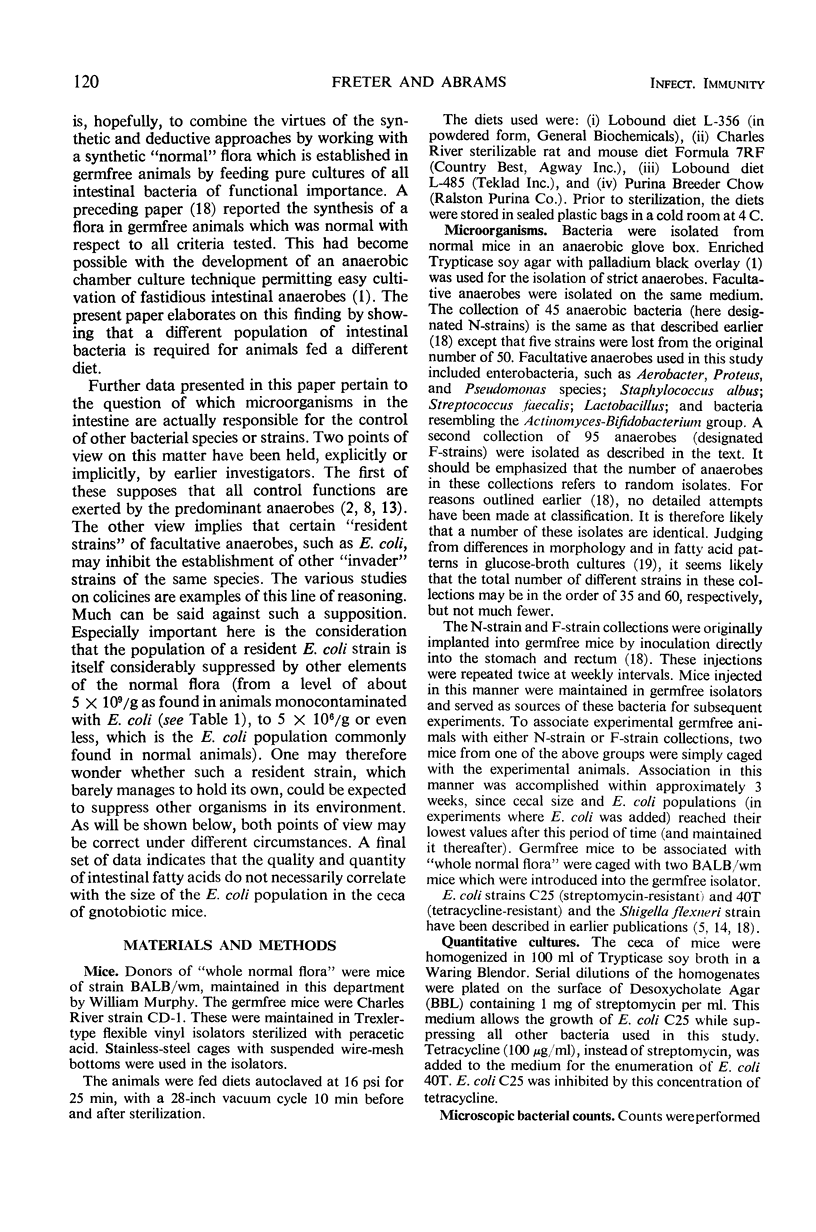
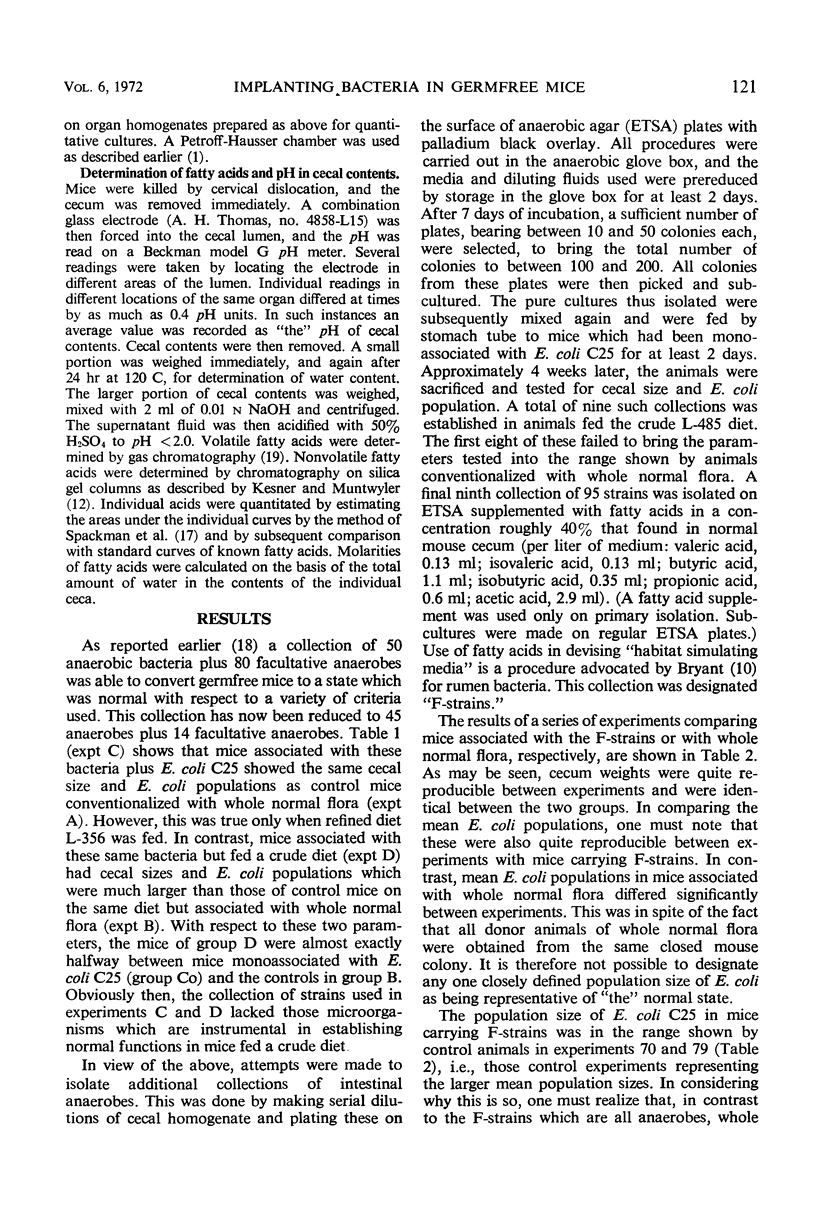
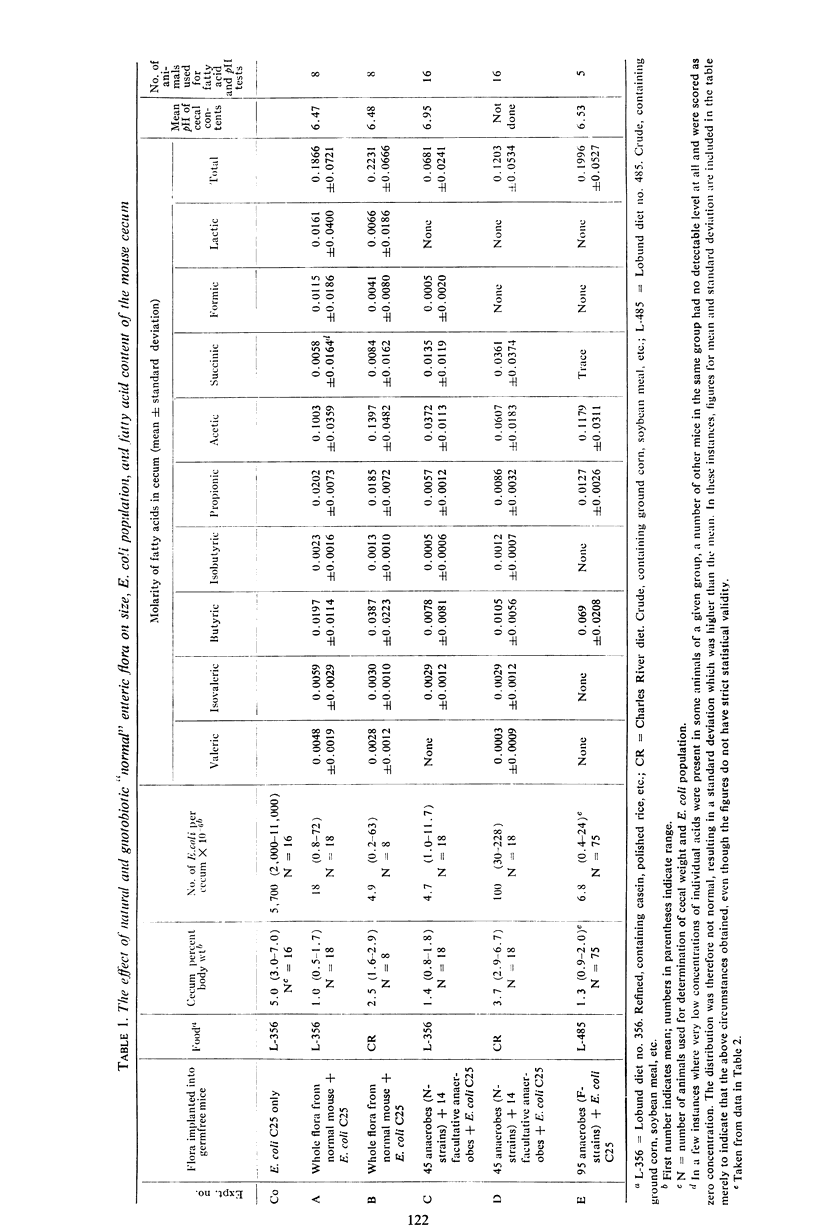

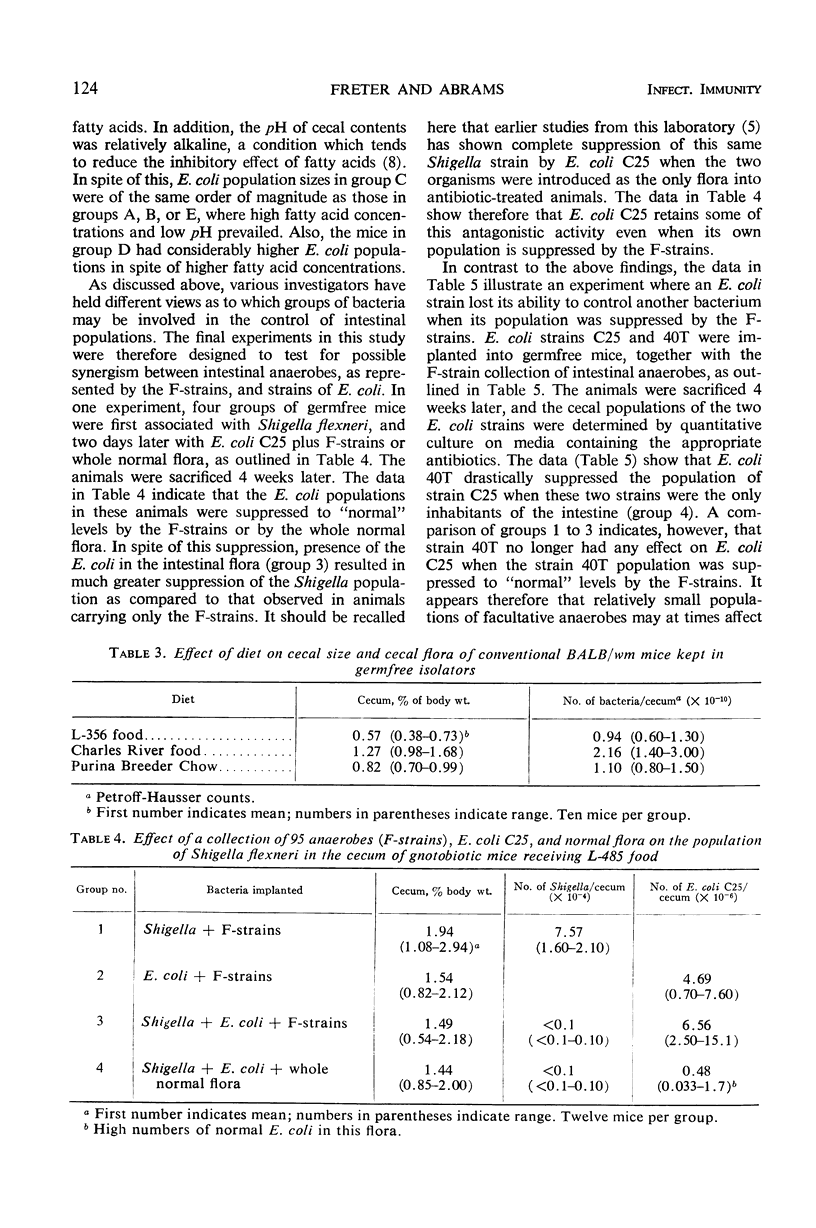
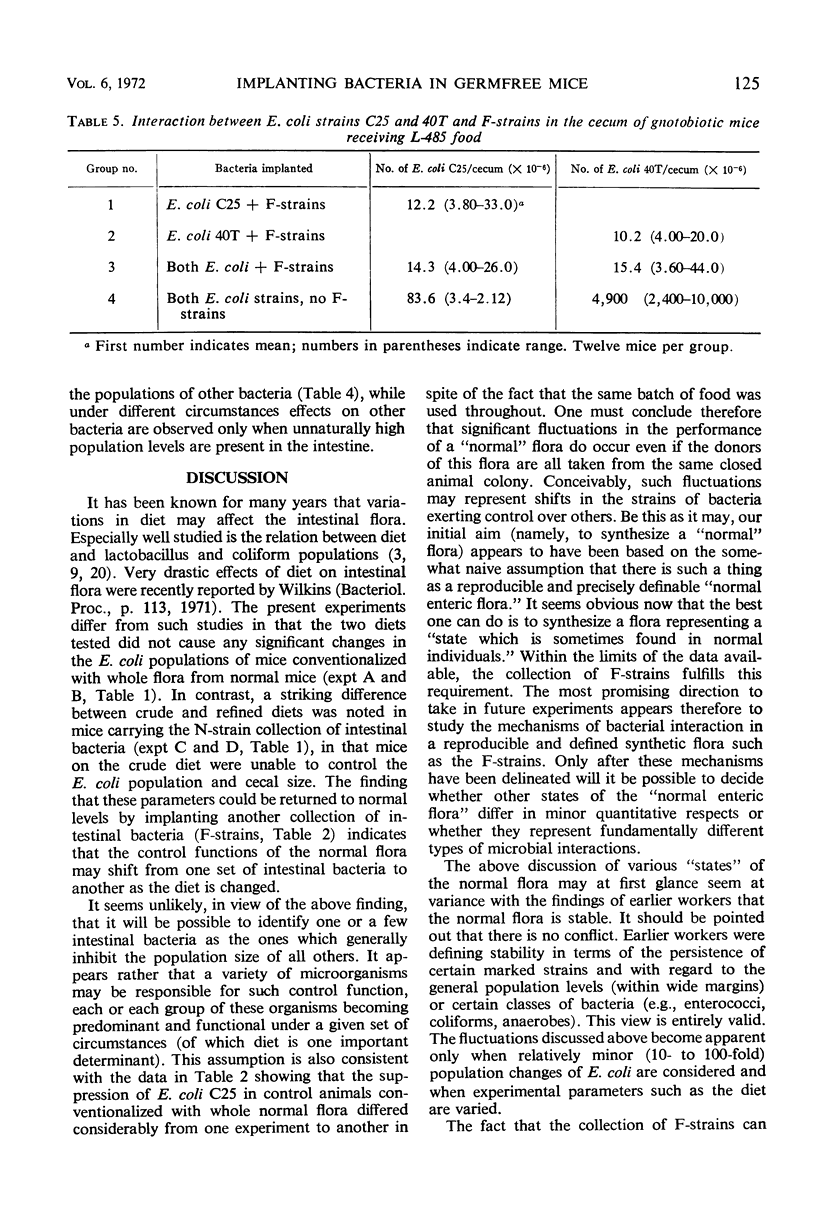

Selected References
These references are in PubMed. This may not be the complete list of references from this article.
- Arank A., Syed S. A., Kenney E. B., Freter R. Isolation of anaerobic bacteria from human gingiva and mouse cecum by means of a simplified glove box procedure. Appl Microbiol. 1969 Apr;17(4):568–576. doi: 10.1128/am.17.4.568-576.1969. [DOI] [PMC free article] [PubMed] [Google Scholar]
- BOHNHOFF M., MILLER C. P., MARTIN W. R. RESISTANCE OF THE MOUSE'S INTESTINAL TRACT TO EXPERIMENTAL SALMONELLA INFECTION. II. FACTORS RESPONSIBLE FOR ITS LOSS FOLLOWING STREPTOMYCIN TREATMENT. J Exp Med. 1964 Nov 1;120:817–828. doi: 10.1084/jem.120.5.817. [DOI] [PMC free article] [PubMed] [Google Scholar]
- DUBOS R. J., SCHAEDLER R. W. The effect of diet on the fecal bacterial flora of mice and on their resistance to infection. J Exp Med. 1962 Jun 1;115:1161–1172. doi: 10.1084/jem.115.6.1161. [DOI] [PMC free article] [PubMed] [Google Scholar]
- FRETER R. In vivo and in vitro antagonism of intestinal bacteria against Shigellaflexneri. II. The inhibitory mechanism. J Infect Dis. 1962 Jan-Feb;110:38–46. doi: 10.1093/infdis/110.1.38. [DOI] [PubMed] [Google Scholar]
- FRIEDMAN D. R., HALBERT S. P. Mixed bacterial infections in relation to antibiotic activities. IV. Shigella-Escherichia coli infections. J Immunol. 1960 Jan;84:11–19. [PubMed] [Google Scholar]
- Floch M. H., Gershengoren W., Diamond S., Hersh T. Cholic acid inhibition of intestinal bacteria. Am J Clin Nutr. 1970 Jan;23(1):8–10. doi: 10.1093/ajcn/23.1.8. [DOI] [PubMed] [Google Scholar]
- Gordon J. H., Dubos R. The anaerobic bacterial flora of the mouse cecum. J Exp Med. 1970 Aug 1;132(2):251–260. doi: 10.1084/jem.132.2.251. [DOI] [PMC free article] [PubMed] [Google Scholar]
- HUNGATE R. E., BRYANT M. P., MAH R. A. THE RUMEN BACTERIA AND PROTOZOA. Annu Rev Microbiol. 1964;18:131–166. doi: 10.1146/annurev.mi.18.100164.001023. [DOI] [PubMed] [Google Scholar]
- Hentges D. J. Enteric pathogen--normal flora interactions. Am J Clin Nutr. 1970 Nov;23(11):1451–1456. doi: 10.1093/ajcn/23.11.1451. [DOI] [PubMed] [Google Scholar]
- Hull T. G., Rettger L. The Influence of Milk and Carbohydrate Feeding on the Character of the Intestinal Flora: IV. Diet versus Bacterial Implantation. J Bacteriol. 1917 Jan;2(1):47–71. doi: 10.1128/jb.2.1.47-71.1917. [DOI] [PMC free article] [PubMed] [Google Scholar]
- Ikari N. S., Kenton D. M., Young V. M. Interaction in the germfree mouse intestine of colicinogenic and colicin-sensitive microorganisms. Proc Soc Exp Biol Med. 1969 Apr;130(4):1280–1284. doi: 10.3181/00379727-130-33773. [DOI] [PubMed] [Google Scholar]
- Kesner L., Muntwyler E. Automatic determination of weak organic acids by partition column chromatography and indicator titration. Anal Chem. 1966 Aug;38(9):1164–1168. doi: 10.1021/ac60241a010. [DOI] [PubMed] [Google Scholar]
- MEYNELL G. G. Antibacterial mechanisms of the mouse gut. II. The role of Eh and volatile fatty acids in the normal gut. Br J Exp Pathol. 1963 Apr;44:209–219. [PMC free article] [PubMed] [Google Scholar]
- OZAWA A., FRETER R. ECOLOGICAL MECHANISM CONTROLLING GROWTH OF ESCHERICHIA COLI IN CONTINUOUS FLOW CULTURES AND IN THE MOUSE INTESTINE. J Infect Dis. 1964 Jun;114:235–242. doi: 10.1093/infdis/114.3.235. [DOI] [PubMed] [Google Scholar]
- SEARS H. J., JANES H., SALOUM R., BROWNLEE I., LAMOREAUX L. F. Persistence of individual strains of Escherichia coli in man and dog under varying conditions. J Bacteriol. 1956 Mar;71(3):370–372. doi: 10.1128/jb.71.3.370-372.1956. [DOI] [PMC free article] [PubMed] [Google Scholar]
- Savage D. C., Dubos R., Schaedler R. W. The gastrointestinal epithelium and its autochthonous bacterial flora. J Exp Med. 1968 Jan 1;127(1):67–76. doi: 10.1084/jem.127.1.67. [DOI] [PMC free article] [PubMed] [Google Scholar]
- Syed S. A., Abrams G. D., Freter R. Efficiency of various intestinal bacteria in assuming normal functions of enteric flora after association with germ-free mice. Infect Immun. 1970 Oct;2(4):376–386. doi: 10.1128/iai.2.4.376-386.1970. [DOI] [PMC free article] [PubMed] [Google Scholar]
- Wiedemann B., Knothe H. Untersuchungen über die Stabilität der Koliflora des gesunden Menschen. 1. Uber das Vorkommen permanenter und passanter Typen. Arch Hyg Bakteriol. 1969 Aug;153(4):342–348. [PubMed] [Google Scholar]
- Zubrzycki L., Spaulding E. H. STUDIES ON THE STABILITY OF THE NORMAL HUMAN FECAL FLORA. J Bacteriol. 1962 May;83(5):968–974. doi: 10.1128/jb.83.5.968-974.1962. [DOI] [PMC free article] [PubMed] [Google Scholar]


